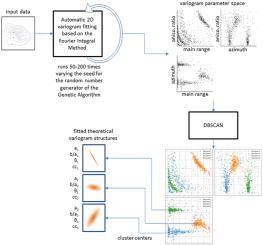Computers & Geosciences ( IF 4.2 ) Pub Date : 2021-07-21 , DOI: 10.1016/j.cageo.2021.104891 Paulo Roberto Moura de Carvalho 1, 2 , João Felipe Coimbra Leite da Costa 1

|
One of the cornerstones of geostatistics is the variogram. Fitting a variogram model to observed data is certainly one of the routine tasks in daily geostatistics practice. The central role of the variogram and the difficulty of performing variogram modeling manually call for an automatic, or at least a computer-assisted, method. Fitting a parametric curve to observational points in an XY chart is far from new and the GSLib software package has included a module (called VARFIT) to perform automatic variogram fitting in 1D since its debut many years ago. Nevertheless, extending its objective function to fitting to variogram map (2D) resulted in a method with poor performance. Hence, this work proposes a computational method to fit variogram models to variogram maps with a different objective function based on the principles of the Fourier Integral Method (FIM). A map is synthesized from the theoretical variogram model using the principles of FIM. The metric of the objective function is the sum of squares of differences between each pixel value of the synthetic map and the input map. The genetic algorithm uses this metric to find the variogram parameters of a model with good fitness. Since the genetic algorithm has a stochastic component, the best fit is not certain. Hence, several runs with different random number generator seeds are performed. The parameters of all fitted models are collected and cluster analysis in parameter space is done with the DBSCAN algorithm. The centers of the clusters are the parameters of the sought variogram model. Open-source software was written and made available, in which the proposed objective function was tested alongside the 2D version of the one in VARFIT. Results showed better effectiveness of the proposed method in fitting variogram models for the variogram map case.
中文翻译:

基于傅里叶积分法的变异函数图自动变异函数模型拟合
地统计学的基石之一是变异函数。将变异函数模型拟合到观测数据当然是日常地质统计学实践中的常规任务之一。变异函数的核心作用和手动执行变异函数建模的困难需要一种自动的或至少是计算机辅助的方法。将参数曲线拟合到 XY 图中的观察点并不是什么新鲜事,GSLib 软件包自多年前首次亮相以来就包含一个模块(称为 VARFIT),用于在 1D 中执行自动变异函数拟合。然而,将其目标函数扩展到拟合变异函数图 (2D) 导致方法性能不佳。因此,这项工作提出了一种计算方法,根据傅立叶积分法 (FIM) 的原理,将变异函数模型拟合到具有不同目标函数的变异函数图。地图是使用 FIM 原理从理论变异函数模型合成的。目标函数的度量是合成图和输入图的每个像素值之间差异的平方和。遗传算法使用该度量来找到具有良好适应度的模型的变异函数参数。由于遗传算法具有随机成分,因此最佳拟合不确定。因此,执行了具有不同随机数生成器种子的多次运行。收集所有拟合模型的参数,并使用 DBSCAN 算法在参数空间中进行聚类分析。聚类的中心是所寻求的变异函数模型的参数。编写并提供了开源软件,其中提议的目标函数与 VARFIT 中目标函数的 2D 版本一起进行了测试。结果表明,所提出的方法在为变异函数图案例拟合变异函数模型方面具有更好的有效性。











































 京公网安备 11010802027423号
京公网安备 11010802027423号